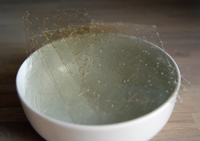
Continuous Surface Polymerization via Fe(II)-Mediated Redox Reaction for Thick Hydrogel Coatings on Versatile Substrates.
Sign Up to like & getrecommendations! Published in 2018 at "Advanced materials"
DOI: 10.1002/adma.201803371
Abstract: The development of versatile generalized strategies for easy surface modification is of immense scientific interest. Herein, a novel mechanism to form functional hydrogel coatings on a wide variety of substrate materials including polymers, polymeric resins,… read more here.
Keywords: polymerization; hydrogel; surface; redox reaction ... See more keywords

A Facile Strategy to Construct Anti-Swelling, Antibacterial and Antifogging Coatings for Protection of Medical Goggles.
Sign Up to like & getrecommendations! Published in 2023 at "Macromolecular bioscience"
DOI: 10.1002/mabi.202300099
Abstract: During the COVID-19 pandemic, traditional medical goggles are not only easy to attach bacteria and viruses in long-term exposure, but also easy to fogged up, which increases the risk of infection and affects productivity. Bacterial… read more here.
Keywords: coatings protection; anti swelling; medical goggles; facile strategy ... See more keywords

Non-delaminating Polymer Hydrogel Coatings via C,H-Insertion Crosslinking (CHic) - A Case Study of Poly(oxanorbornenes).
Sign Up to like & getrecommendations! Published in 2018 at "Macromolecular chemistry and physics"
DOI: 10.1002/macp.201800397
Abstract: Robust, non-delaminating polymer coatings and hydrogels are needed for technical and biomedical applications. This study focusses on surface-attached poly(oxanorbornene) hydrogels obtained by simultaneous UV-activated crosslinking and surface-immobilization. The synthesis and copolymerization of two oxanorbornene monomers… read more here.
Keywords: hydrogel coatings; non delaminating; crosslinking chic; insertion crosslinking ... See more keywords

PLGA microsphere/PVA hydrogel coatings suppress the foreign body reaction for 6 months
Sign Up to like & getrecommendations! Published in 2018 at "Journal of Controlled Release"
DOI: 10.1016/j.jconrel.2018.09.021
Abstract: &NA; The application of dexamethasone releasing poly (lactic‐co‐glycolic acid) (PLGA) microspheres embedded in a poly vinyl alcohol (PVA) hydrogel coatings have been successfully used in the suppression of the foreign body response (FBR) to implantable… read more here.
Keywords: pva hydrogel; foreign body; drug; hydrogel coatings ... See more keywords

Linear shrinkage of hydrogel coatings exposed to flow: interplay between dissolution of water and advective transport.
Sign Up to like & getrecommendations! Published in 2021 at "Soft matter"
DOI: 10.1039/d1sm01297e
Abstract: We investigate the shrinkage of a surface-grafted water-swollen hydrogel under shear flows of oils by laser scanning confocal microscopy. Interestingly, external shear flows of oil lead to linear dehydration and shrinkage of the hydrogel for… read more here.
Keywords: shrinkage hydrogel; linear shrinkage; hydrogel coatings; water ... See more keywords

Effects of crosslink density in zwitterionic hydrogel coatings on their antifouling performance and susceptibility to silt uptake
Sign Up to like & getrecommendations! Published in 2020 at "Biofouling"
DOI: 10.1080/08927014.2020.1796983
Abstract: Abstract Hydrogel coatings effectively reduce the attachment of proteins and organisms in laboratory assays, in particular when made from zwitterionic monomers. In field experiments with multiple species and non-living material, such coatings suffer from adsorption… read more here.
Keywords: hydrogel coatings; antifouling performance; performance; crosslink density ... See more keywords

Functional hydrogel coatings
Sign Up to like & getrecommendations! Published in 2021 at "National Science Review"
DOI: 10.1093/nsr/nwaa254
Abstract: Abstract Hydrogels—natural or synthetic polymer networks that swell in water—can be made mechanically, chemically and electrically compatible with living tissues. There has been intense research and development of hydrogels for medical applications since the invention… read more here.
Keywords: hydrogel coatings; adhesion; functional hydrogel;